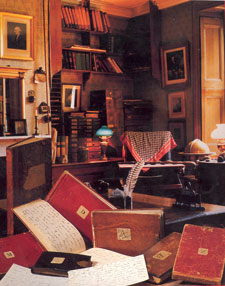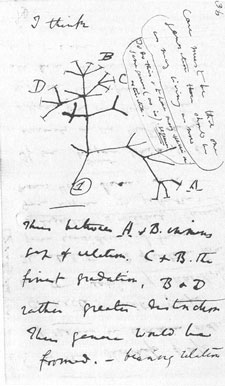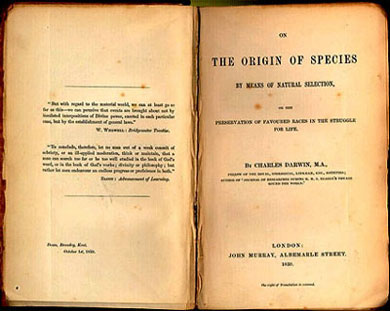|
||||||||||||||||||||||||||||||||||||
On the Origin of Species by means of Natural Selection,
|
|
|
Darwin’s Origin of Species had a long gestation. An examination of its development reveals structures that lie just below the surface of the completed work and determine the significance of its many overt features. Comparable to his own embryological assumption, that genesis leaves a dynamic picture of its deeper evolutionary history. When Darwin returned from his Beagle voyage in fall of 1836, he began sorting the materials he had shipped back to the British Museum . During the following March he consulted the chief ornithologist at the museum, John Gould, about the three varieties of mocking birds he collected on the several islands of the Galapagos. Darwin thought them varieties of one species that had been blown over from the mainland and under environmental pressure had formed three morphological types. Gould, however, maintained they constituted three good species. It seems that this tripped a mind at the ready. In the Red Notebook and through the various transmutation notebooks and early essays (see the “Brief Biographical Sketch” on this website), On 28 September 1838, Darwin read Malthus’s Essay on Population, which he said gave him “a theory by which to work.” With the reading of Malthus, he began formulating his complex principle of natural selection. After completing his work on barnacles in the mid 1850s, Darwin finally resolved to produce a big book on species that would spell out his theory and the myriad of evidence that supported it. His pocket diary records on 14 May 14 1856: “Began by Lyell’s advice writing species sketch.” By the following fall, the sketch grew far beyond his initial intention. His expanding composition was to be called Natural Selection, though he referred to it fondly as his “big species book.” And big it would have been, perhaps extending to two large volumes. When he received Wallace’s letter in late June of 1858, Darwin had just completed the chapter on animal instinct, which would form the seventh chapter of the Origin. He had also just solved a problem that had been plaguing him since the mid 1840s and threatened to undermine, as he judged, his whole theory. He finally understood how to explain the wonderful instincts and morphologies of the social insects. The problem that originally stumped him was how to account for the structures of work bees and ants. Natural selection preserves individuals that have advantages traits, so that through generations those traits will gradually built up in the progeny. But worker bees and ants are neuters; they leave no progeny. Only in the composition of the chapter on instinct in the big species book did Darwin hit upon the solution: natural selection operates on the whole hive or nest to preserve those communities whose members have advantageous traits. The solution to this perplexing problem would lead Darwin to the final version of his theory of morality, which he expanded in the Descent of Man. There Darwin argued that the altruism that constituted authentic moral action arose through natural selection operating on the small clan-groups of our ancestors, groups whose members would likely be fairly closely related. Those group that had members displaying such altruistic virtues as courage, fidelity, and cooperation would have the advantage over other groups with fewer such members. As mental and cultural evolution progressed, and individuals began to understand that non-relatives were nonetheless brothers and sisters under the skin, altruistic instincts would be extended to an ever wider circle. This essentially is the core of the several theories of the evolution of morality being formulated today.
|
After receiving Wallace’s letter, Darwin began to reduce the size of the chapters he had already completed, eliminating most of the references and discussions of particular cases; he then added the further chapters that rounded out the Origin. What the book lost in detailed evidentiary considerations and minute analyses, it gained in flow of ideas, over-all intelligibility, and ultimately persuasiveness. Not only did the logic of the argument stand out, but the tropes and metaphors that Darwin honed made smooth the way to conviction. An example is the presentation of the principle of natural selection itself. In the third chapter, entitled “The Struggle for Existence,” Darwin offers a brief expression of the principle: “Owing to this struggle for life, any variation, however slight and from whatever cause proceeding, if it be in any degree profitable to an individual of any species, in its infinitely complex relations to other organic beings and to external nature, will tend to the preservation of that individual, and will generally be inherited by its offspring” (p. 61). The rest of the chapter explores the many meanings of “struggle.” Darwin discriminated three different kinds of struggle: individuals of the same species with one another (e.g., two dogs struggling over food); individuals of different species (e.g., a rabbit struggling to escape a fox), and individuals struggling against a hostile environment (e.g., a plant at the edge of the desert). Contemporary neo-Darwinians collapse these types into one: the differential reproductive rates of individuals of the same species by reason of their causal relation to the environment. Darwin’s own characterization bears a nineteenth century stamp; it is the scientific version of Tennyson’s “nature red in tooth and claw.” The image of dogs struggling over a scrap of meat or of a lonely plant bordering a parched desert brought home to Darwin’s readers a feeling for the causes of selection more vividly than what we might regard as the denuded, abstract contemporary formulation. Chapter 4, entitled “Natural Selection,” shows even more strikingly the power of Darwin’s rhetorical construction, a deployment of tropes that carry metaphysical weight. Darwin harkened back to his initial image in the essays, that of an all-powerful, omniscient, intelligent selector. “Man can act only on external and visible characters. Nature,” he insisted, “cares nothing for appearances, except in so far as they may be useful to any being. She can act on every internal organ, on every shade of constitutional difference, on the whole machinery of life. Man selections only for his own good; nature only for that of the being which she tends” (p. 83). Continuing in prose that marches to the cadence of Milton’s poetry (which accompanied him on the Beagle), he declared: “Can we wonder, then that nature’s productions should be far ‘truer’ in character than man’s productions; that they should be infinitely better adapted to the most complex conditions of life, and should plainly bear the stamp of far higher workmanship?” (p. 84). Not skipping a beat, he described natural selection as intelligently acting altruistically, penetrating into the very fabric of organisms in a way that no machine could: “It may be said that natural selection is daily and hourly scrutinizing, throughout the world, every variation, even the slightest; rejecting that which is bad preserving and adding up all that is good; silently and insensibly working, whenever and wherever opportunity offers, at the improvement of each organic being in relation to its organic and inorganic conditions of life” (p. 84). In Darwin’s construction of evolution, nature as selector worked with deep discernment to improve each creature; nature showed moral concern for their welfare, not wielding the winnowing scythe, but crafting “true” products, and ultimately the higher animals, including human beings. Darwin’s language, which portended perhaps more than he consciously intended, yet formulated a theory that displayed the deep ancestry of both British natural theology and German Romantic thought (the latter which he imbibed from Alexander von Humboldt and the British mediator of German thought, Richard Owen). Darwin’s great book ought to convince the astute reader that he was no neo-Darwinian. RJR Select Bibliography of Secondary SourcesBowler, Peter, Evolution: the History of an Idea, 3rd ed. (Johns Hopkins, 2003) Coyne, Jerry, Why Evolution is True (Viking Press, 2009) Dennett, Daniel C. Darwin’s Dangerous Idea (Simon and Schuster, 1995). Hodge, Jonathan and Gregory Radick (eds.), Cambridge Companion to Darwin, 2nd ed. (Cambridge University Press, 2008) Larson, Edward, Summer of the Gods: The Scopes Trial (Harvard University Press, 1998) Richards, Robert J., Darwin and the Emergence of Evolutionary Theories of Mind and Behavior (University of Chicago Press, 1987) Richards, Robert J. and Michael Ruse (eds.), Cambridge Companion to the Origin of Species (Cambridge University Press, 2008) Ruse, Michael, The Darwinian Revolution, 2nd ed. (University of Chicago Press, 1999).
|
|
Conference | Registration | Chicago | Contacts © 2008 University of Chicago |



 Darwin slowly constructed his theory. Prior to hitting on the device of natural selection in September 1838, he explored three different hypothesis by which to account for species change. The first assumption was that species, much like individuals, were born of antecedent species, which they resembled. Species, according to this view, had an extended period of life and then succumbed to senescence. He quickly abandoned that idea in July of 1837, and adopted a line of thought quite similar to that of Lamarck: spontaneous generations of monads that progressively changed but were given specific shape by the direct impact of the environment. In late 1837 and through the first half of the next year, Darwin began formulating another hypothesis that he thought would separate his developing theory from that of Lamarck: he supposed that animals initially adopted new habits that would allow them to survive in a given environment and that these habits would gradually become innate, and thus displayed as unconscious instincts; the exercise of instincts, in turn, would then gradually mold anatomy into new forms. Darwin thought that because instincts were unconscious, he had distinguished his theory from Lamarck’s, who, he believed, postulated will-power as the force of anatomical change. After formulating the elements of the idea of natural selection in fall of 1838, Darwin reduced the role of the last two hypotheses, but never completely abandoned them. From the first edition of the Origin of Species to the last, he employed the inheritance of acquired characteristics to explain various phenomena, presuming as well that it could furnish variations upon which natural selection might operate.
Darwin slowly constructed his theory. Prior to hitting on the device of natural selection in September 1838, he explored three different hypothesis by which to account for species change. The first assumption was that species, much like individuals, were born of antecedent species, which they resembled. Species, according to this view, had an extended period of life and then succumbed to senescence. He quickly abandoned that idea in July of 1837, and adopted a line of thought quite similar to that of Lamarck: spontaneous generations of monads that progressively changed but were given specific shape by the direct impact of the environment. In late 1837 and through the first half of the next year, Darwin began formulating another hypothesis that he thought would separate his developing theory from that of Lamarck: he supposed that animals initially adopted new habits that would allow them to survive in a given environment and that these habits would gradually become innate, and thus displayed as unconscious instincts; the exercise of instincts, in turn, would then gradually mold anatomy into new forms. Darwin thought that because instincts were unconscious, he had distinguished his theory from Lamarck’s, who, he believed, postulated will-power as the force of anatomical change. After formulating the elements of the idea of natural selection in fall of 1838, Darwin reduced the role of the last two hypotheses, but never completely abandoned them. From the first edition of the Origin of Species to the last, he employed the inheritance of acquired characteristics to explain various phenomena, presuming as well that it could furnish variations upon which natural selection might operate. He continued to shape the principles, its subordinate parts, and their applications for the rest of his career. In his essays of 1842 and 1844, he modeled the actions of natural selection on an all-powerful intellect that would select creatures for their own advantage (unlike man’s selection of creatures for his selfish interests) and for their beauty. Nature, acting as selector, would produce ever more progressive creatures and would ultimately explain the origin of human beings and their moral sentiments. As he would phrase it in the Origin: “And as natural selection works solely by and for the good of each being, all corporeal and mental endowments will tend to progress towards perfection” (p. 489). Darwin proposed in his notebooks (Notebook E, MS pp. 48-49) that his theory provided the “final cause” or purpose for the existence of sexual generation: sexual generation produced stable species and made possible the existence of social species; and social species were a necessary condition for the development of that most progressive of animals, human beings with their moral sentiments. Thus a few days after he initially formulated his principle of natural selection, he opened his Notebook N, in which he began to work on a theory of the evolution of morality. The purpose—or as he phrased it on the last page of the Origin, “the most exalted object we are capable of conceiving”—of natural selection was the production of ever more progressive creatures, ultimately moral creatures. In this conception, Nature as selector took on all of the traits of the recently departed deity: infinite creative ability, far-sightedness, concern for creatures, ever more improved organisms, slow patient operation, and the great final cause, the production of a moral creature.
He continued to shape the principles, its subordinate parts, and their applications for the rest of his career. In his essays of 1842 and 1844, he modeled the actions of natural selection on an all-powerful intellect that would select creatures for their own advantage (unlike man’s selection of creatures for his selfish interests) and for their beauty. Nature, acting as selector, would produce ever more progressive creatures and would ultimately explain the origin of human beings and their moral sentiments. As he would phrase it in the Origin: “And as natural selection works solely by and for the good of each being, all corporeal and mental endowments will tend to progress towards perfection” (p. 489). Darwin proposed in his notebooks (Notebook E, MS pp. 48-49) that his theory provided the “final cause” or purpose for the existence of sexual generation: sexual generation produced stable species and made possible the existence of social species; and social species were a necessary condition for the development of that most progressive of animals, human beings with their moral sentiments. Thus a few days after he initially formulated his principle of natural selection, he opened his Notebook N, in which he began to work on a theory of the evolution of morality. The purpose—or as he phrased it on the last page of the Origin, “the most exalted object we are capable of conceiving”—of natural selection was the production of ever more progressive creatures, ultimately moral creatures. In this conception, Nature as selector took on all of the traits of the recently departed deity: infinite creative ability, far-sightedness, concern for creatures, ever more improved organisms, slow patient operation, and the great final cause, the production of a moral creature. 